The Helix Nebula (NGC 7293) is a bright, large planetary nebula located 650 light years from Earth in the constellation Aquarius. It is one of the closest planetary nebulae to Earth, as well as one of the brightest. With an apparent magnitude of 7.6 and an apparent size of 25 arcminutes, the nebula is visible in binoculars and easily observed in small telescopes in good conditions. Its striking appearance has earned it the nickname the Eye of God Nebula.
Planetary nebulae like the Helix are formed when stars that are not massive enough to go out as supernovae expel their outer envelopes at the end of their evolutionary cycles. The stars become white dwarfs – hot remnant stellar cores – that energize the ejected material. White dwarfs are very dense, typically packing a mass similar to that of the Sun into a volume comparable to that of the Earth. The intense ultraviolet radiation from these stars causes the ejected layers of gas to glow.
The Helix Nebula is believed to have formed about 10,600 years ago, when the central star, catalogued as GJ 9785, reached the end of its life cycle and shed its outer layers into space. The nebula’s age is believed to be in the range between 9,400 and 12,900 years based on the measured expansion rate of 31 km/s−1.
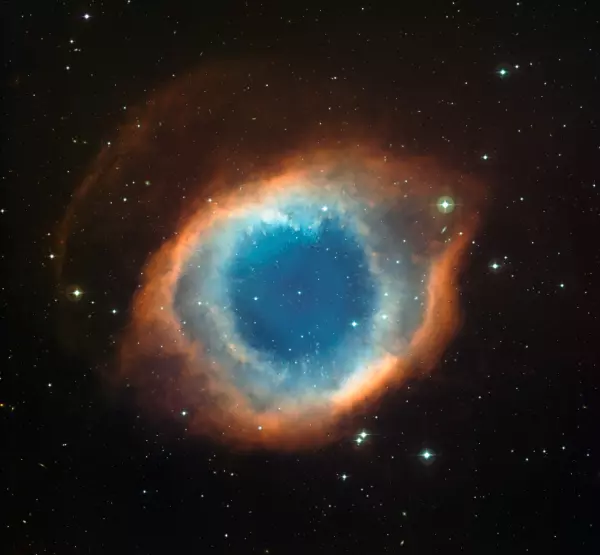
This colour-composite image of the Helix Nebula (NGC 7293) was created from images obtained using the the Wide Field Imager (WFI), an astronomical camera attached to the 2.2-metre Max-Planck Society/ESO telescope at the La Silla observatory in Chile. The blue-green glow in the centre of the Helix comes from oxygen atoms shining under effects of the intense ultraviolet radiation of the 120 000 degree Celsius central star and the hot gas. Further out from the star and beyond the ring of knots, the red colour from hydrogen and nitrogen is more prominent. A careful look at the central part of this object reveals not only the knots, but also many remote galaxies seen right through the thinly spread glowing gas. This image was created from images through blue, green and red filters and the total exposure times were 12 minutes, 9 minutes and 7 minutes respectively. Image: ESO
The central star has the stellar classification DAO.5, indicating a hydrogen-rich white dwarf. About 80% of known white dwarfs have hydrogen-dominated atmospheres. A 1999 study by R. B. C. Henry found a mass 6.5 times that of the Sun for the progenitor star. An earlier study determined a mass of 0.93 solar masses for the white dwarf, while more recent studies found a mass of 0.57 solar masses with an effective temperature of 120,000 K and a luminosity 76 times that of the Sun.
NGC 7293 is called the Helix Nebula because, from our point of view, the nebula’s gases form a pattern similar to that of a helix structure seen from the top. The double-ringed structure appears like two coils on a spring. The Helix is not to be confused with the Double Helix Nebula, an emission nebula near the centre of the Milky Way, which has the shape of a DNA molecule seen from the side.
The appearance of the Helix Nebula is recognizable across the spectrum. The double-ring structure appears in images taken in every band, from ultraviolet to infrared.
In 1998, American astronomer C. R. O’Dell proposed that the ring was really a thick disk. The 1999 study by R. B. C. Henry confirmed O’Dell’s model and found that the Helix was a disk about 1 parsec in diameter and 0.33 parsecs in thickness. The model indicated that the disk was inclined about 30 degrees with respect to the plane of the sky around an axis with a position angle of 22 degrees.
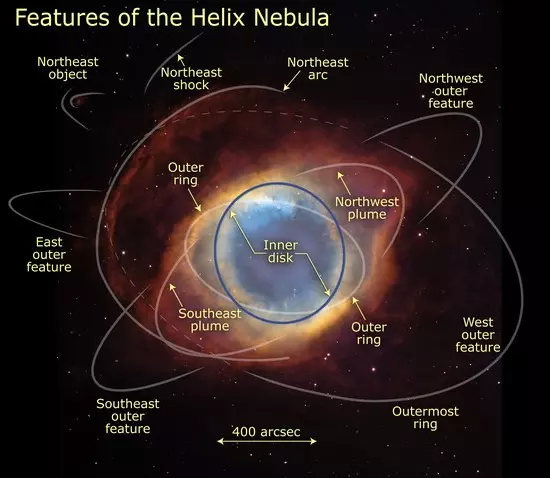
The features of the Helix Nebula, image: NASA (Hubble Space Telescope)
The Helix Nebula is believed to consist of two almost perpendicular gaseous disks. The central region is dominated by highly ionized gas and surrounded by inner and outer rims.
The nebula stretches 5,74 light years across. The main ring spans about two light years and the nebula’s material spreads out further to at least another two light years. The outermost ring has an apparent size of 25 arcminutes – almost the size of the full Moon – while the outer torus occupies an area of 12×22 arcminutes. The bright inner disk has an angular size of 8×19 arcminutes. It is believed to have started expanding about 12,100 years ago, while the entire nebula has been expanding for the past 6,560 years. The inner disk expands at a rate of 32 km/s, while the outer ring speeds outwards at 40 km/s.
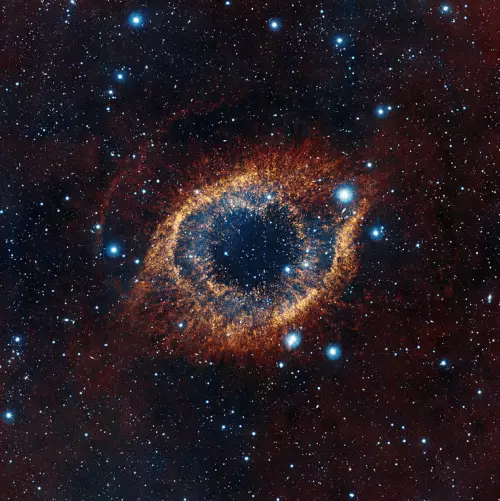
ESO’s Visible and Infrared Survey Telescope for Astronomy (VISTA) has captured this unusual view of the Helix Nebula (NGC 7293), a planetary nebula located 700 light-years away. The coloured picture was created from images taken through Y, J and K infrared filters. While bringing to light a rich background of stars and galaxies, the telescope’s infrared vision also reveals strands of cold nebular gas that are mostly obscured in visible images of the Helix. Image: ESO/VISTA/J. Emerson, 2012
Facts
The Helix Nebula is one of the brightest planetary nebulae in the sky. It is rivalled only by the Dumbbell Nebula (Messier 27, mag. 7.5) in the constellation Vulpecula and the Saturn Nebula (mag. 8.0) in Aquarius. The Ring Nebula (Messier 57) in Lyra, which has a similar appearance to the Helix, is considerably fainter at magnitude 8.8.
Even though it is brighter and larger than the four planetary nebulae listed in Messier’s catalogue – the Dumbbell Nebula (M27), Ring Nebula (M57), Little Dumbbell Nebula (M76, mag. 10.1) and Owl Nebula (M97, mag. 9.9) – the Helix Nebula was not catalogued by Charles Messier. It is considered to be one of the French astronomer’s most notable omissions. In fact, when the final version of the Messier catalogue was published in the 1780s, the Helix had still not been catalogued by any astronomer. Its exceptionally large size and low surface brightness no doubt contributed to it not being spotted by Messier or by William and John Herschel.
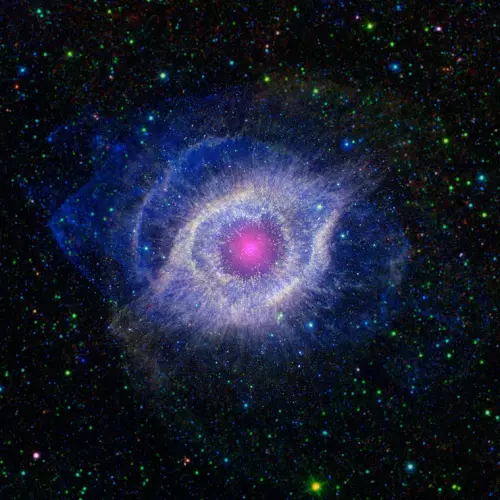
A combined infrared and ultraviolet image of the Helix Nebula from NASA’s Spitzer Space Telescope and the Galaxy Evolution Explorer (GALEX). Infrared data from Spitzer for the central nebula is rendered in green (wavelengths of 3.6 to 4.5 microns) and red (8 to 24 microns), with WISE data covering the outer areas in green (3.4 to 4.5 microns) and red (12 to 22 microns). Ultraviolet data from GALEX appears as blue (0.15 to 2.3 microns). Image: NASA/JPL-Caltech
The Helix Nebula was discovered by the German astronomer Karl Ludwig Harding at the Göttingen Observatory in 1824 or earlier. Harding probably spotted it in a 8.5-inch reflector during his sky surveys before 1824.
The Helix Nebula was the first object of its kind discovered to harbour cometary knots. Also known as globules, these structures can only be observed in the nearest planetary nebulae, but are believed to occur in all of them as the nebulae evolve. The Helix Nebula contains about 40,000 globules. Most of them are larger than the solar system and have masses comparable to that of the Earth. This makes them at least 1,000 times denser than the surrounding material. A 1996 study found an expansion velocity of 10 km/s-1 for the globules, which is considerably slower than the rest of the nebula.
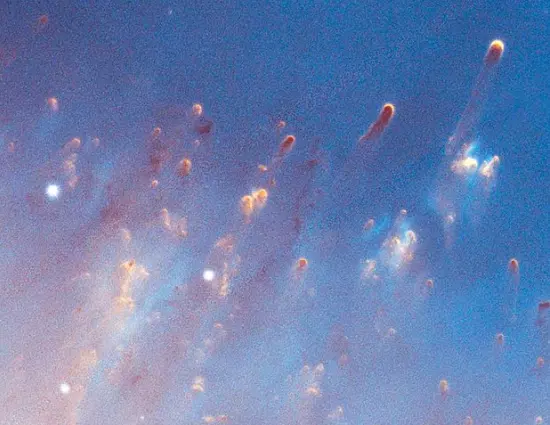
Cometary knots in the Helix Nebula, image: NASA, NOAO, ESA, the Hubble Helix Nebula Team, M. Meixner (STScI), and T.A. Rector (NRAO)
Observations with the Subaru Telescope at the National Astronomical Observatory of Japan in 2007 revealed that the knots were found at distances of 2’.2 to 6’.4 from the nebula’s central star, from the inner edge to the outer ring. The knots closer to the central star have distinct tails that make them appear like comets speeding away from the star, while those farther away do not have such defined tails. The origin of globules in the Helix and other planetary nebulae is still not fully understood.
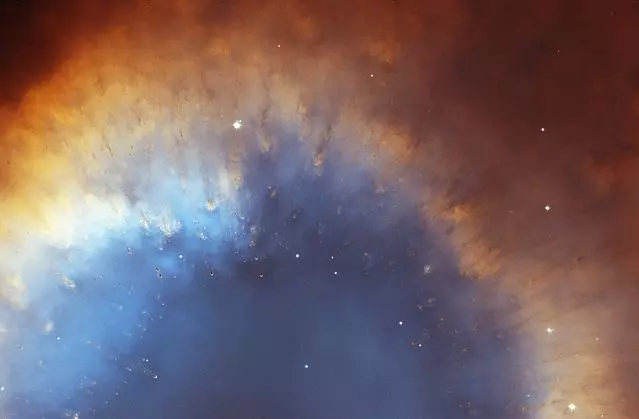
This cropped version of the Helix Nebula mosaic shows cometary-filaments embedded along a portion of the inner rim of the nebula’s red and blue gas ring. At a distance of 650 light-years, the Helix is one of the nearest planetary nebulae to Earth. The composite picture is a seamless blend of ultra-sharp NASA Hubble Space Telescope (HST) Advanced Camera for Surveys images combined with the wide view of the Mosaic Camera on the National Science Foundation’s 0.9-meter telescope at Kitt Peak National Observatory, part of the National Optical Astronomy Observatory, near Tucson, Ariz. Image: NASA, NOAO, ESA, the Hubble Helix Nebula Team, M. Meixner (STScI), and T.A. Rector (NRAO)
The Helix Nebula is not the only famous nebula that looks like an eye. In addition to the Ring Nebula, with which it is often confused, there are the Glowing Eye Nebula (NGC 6751) in Aquila, Cat’s Eye Nebula (NGC 6543) in Draco, Little Ghost Nebula (NGC 6369) in Ophiuchus, and the Eight-Burst Nebula (Southern Ring Nebula, NGC 3132) in Vela.
Distance
The distance of the Helix Nebula was uncertain until relatively recently. The value of 650 light years is based on the observations of the Gaia space observatory, launched in 2013. Earlier estimates placed the nebula much closer to Earth. The first estimate was made by the Dutch astronomer Adriaan van Maanen, who determined a distance of only 85 light years. Subsequent determinations ranged from 160 to 590 light years.
Eye of God Nebula
The Helix Nebula was nicknamed the Eye of God or God’s Eye Nebula because it appears like a giant eye in space. The nickname started appearing after the release of the image taken by the NASA Hubble Space Telescope in November 2002. The infrared image taken by the Spitzer Space Telescope, showing the eye in different colours, followed in 2007.
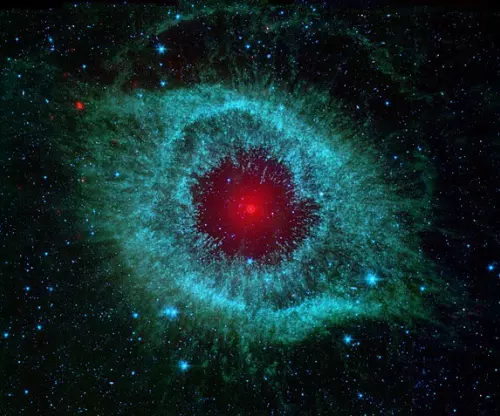
In Spitzer’s infrared view of the Helix nebula, the eye looks more like that of a green monster’s. Infrared light from the outer gaseous layers is represented in blues and greens. The white dwarf is visible as a tiny white dot in the center of the picture. The red color in the middle of the eye denotes the final layers of gas blown out when the star came to the end of its life cycle. The brighter red circle in the very center is the glow of a dusty disk circling the white dwarf (the disk itself is too small to be resolved). This dust, discovered by Spitzer’s infrared heat-seeking vision, was most likely kicked up by comets that survived their star. Before the star met its end, its comets and possibly planets would have orbited the star in an orderly fashion. But when the star blew off its outer layers, the icy bodies and outer planets would have been tossed about and into each other, resulting in an ongoing cosmic dust storm. Any inner planets in the system would have burned up or been swallowed as their star expanded. Image: NASA/JPL-Caltech/Univ. of Ariz.
The Helix Nebula is also sometimes called the Eye of Sauron. It shares this nickname with M 1-42 in Sagittarius, which has a similar look, but resembles the elongated Eye of Sauron more than the Helix.
Location
The Helix Nebula can be challenging to find in less-than-ideal conditions. It is located in an area of the sky without any recognizable features and with no bright stars in its immediate vicinity. The Water Jar asterism and the brightest stars in Aquarius lie in the northern part of the constellation, near the border with Pegasus, while the Helix lies near the southern border with Piscis Austrinus.
The nearest first-magnitude star is Fomalhaut in Piscis Austrinus, which lies about 10 degrees southeast of the nebula. The magnitude 5.21 star Upsilon Aquarii lies only 1.2 degrees east of the nebula, but is difficult to see from light-polluted areas.
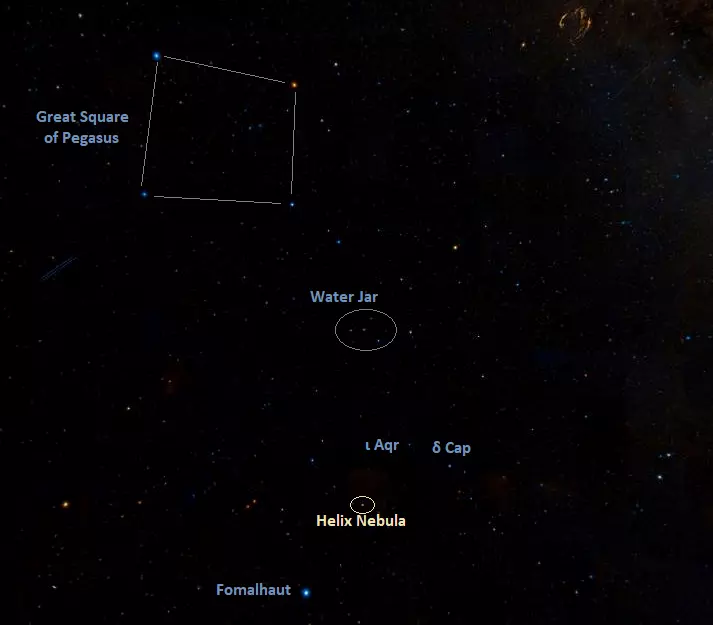
Helix Nebula location, image: Wikisky
The Helix Nebula can be found roughly halfway between Fomalhaut and Iota Aquarii, a star marking the Water Bearer’s calf. Iota Aquarii is visible to the unaided eye, but inconspicuous at magnitude 4.279. It lies just east of Deneb Algedi (Delta Capricorni), the brightest point of light (mag. 2.81) in the relatively faint Capricornus and the easternmost (leftmost) star in the V-shaped pattern of the celestial Sea Goat.
Fomalhaut (curiously also nicknamed the Eye of Sauron for its large circumstellar disk) can be found using the stars of the Great Square of Pegasus. A line extended from the two western (right) stars of the Great Square to the south leads directly to Fomalhaut. The luminary of Piscis Austrinus is the only exceptionally bright star in this part of the sky.
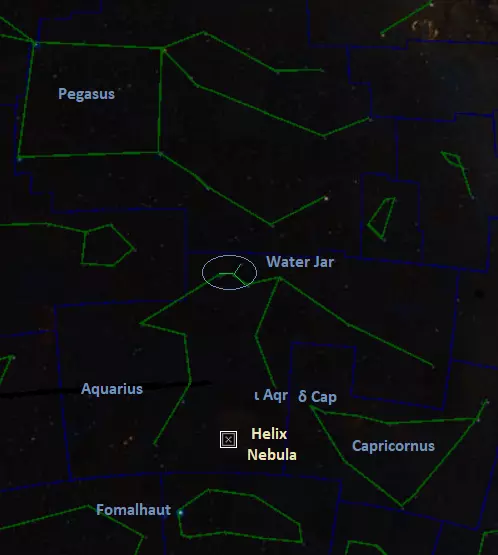
Location of the Helix Nebula in Aquarius, image: Wikisky
The Helix Nebula is best observed in small telescopes, which reveal an oval patch of nebulosity half the size of the full Moon. In telescopes with a narrow field of view, the nebula may be missed entirely because it is very large and has low surface brightness. Even though it is one of the brightest planetary nebulae in the sky, its light is spread across a large area and it requires exceptionally clear, dark skies to be seen.
Smaller telescopes and wide fields concentrate the nebula’s light, making it easier to find and observe. 4-inch telescopes reveal the ring structure in good conditions and the central star is visible in 6-inch instruments. A UHC or OIII filter is recommended for a better viewing experience, to bring out the details of the nebula.
The best time of year to observe the Helix Nebula and other deep sky objects in Aquarius is during the month of October, when the constellation rises high above the horizon in the evening sky.
Helix Nebula – NGC 7293
| Constellation | Aquarius |
| Right ascension | 22h 29m 38.5453078023s |
| Declination | -20° 50’ 13.746093105’’ |
| Distance | 650 light years (200 parsecs) |
| Apparent magnitude | 7.6 |
| Angular size | 25’ |
| Radius | 2.87 light years (0.88 parsecs) |
| Expansion rate | 31 km·s−1 |
| Spectral type (central star) | DAO.5 |
| Radial velocity | -15.0 ± 10 km/s |
| Proper motion | RA: 38.869 ± 0.155 mas/yr |
| Dec.: -3.419 ± 0.119 mas/yr | |
| Parallax | 4.9760 ± 0.0 763 mas |
| Age | 10,600 years (9,400 – 12,900 years) |
| Names and designations | Helix Nebula, Eye of God, God’s Eye Nebula, NGC 7293, Caldwell 63, ESO 602-22, PN G036.1-57.1, ARO 17, VV’ 563, VV 275, PK 036-57, PKS J2229-2050, PK 036-57, PKS 2226-211, USNO 271, GJ 9785, PLX 5437.00, GCRV 14134, IRAS 22267-2102, 2MASS J22293854-2050136, Gaia DR2 6628874205642084224 |